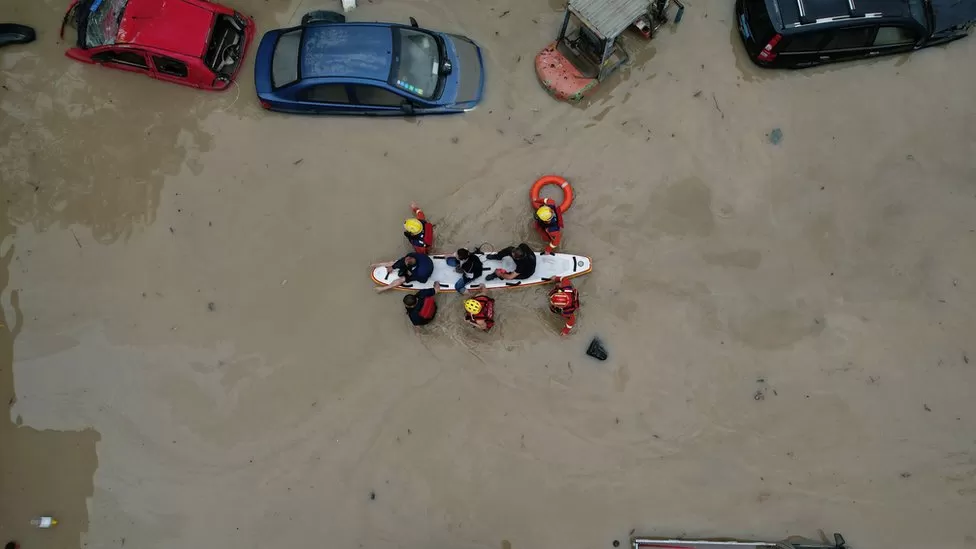Asia is currently facing a severe monsoon season, resulting in the loss of more than 100 lives across the region this month. The past two weeks have witnessed relentless rainfall, triggering floods and landslides in countries like India, China, and Japan. These calamities have forced hundreds of thousands of individuals to evacuate their homes in order to ensure their safety.
South Korea was particularly on high alert last Friday as a powerful storm battered its capital city, Seoul. In the Philippines, officials issued warnings about an approaching tropical cyclone. Earlier this week, Japan witnessed record-breaking floods on Kyushu Island, claiming the lives of at least eight people, including a local politician, with others still reported missing.
The spokesman for Japan’s meteorological agency expressed astonishment, stating, “It’s raining like never before,” as cities across the country recorded unprecedented levels of precipitation. Scientists emphasize that climate change has amplified the risk of flooding worldwide, and numerous nations are struggling to cope with the hazards posed by extreme weather events.
Stefan Uhlenbrook, the World Meteorological Organization’s director of hydrology, water, and cryosphere, noted that developed countries like Japan are “extremely alert and well prepared” in terms of flood management measures. However, he highlighted the significant lack of warning systems, flood defense structures, and integrated flood management in low-income countries.
READ MORE:
Kuwait Declared the Worst Country for Expats
Japanese authorities, in response to the dire situation, evacuated more than 420,000 residents from two prefectures on Kyushu Island. Urgent orders were issued, emphasizing the immediate need for action to protect lives. In Seoul, 135 individuals were evacuated on Friday as torrential rain struck the South Korean capital, causing power outages in approximately 4,000 households.
During an emergency meeting with government agencies, Prime Minister Han Duck-soo declared that preventing casualties was the nation’s foremost priority. He urged all public officials to remain vigilant and committed until the end of the monsoon season. Additionally, he cautioned officials to thoroughly prepare for the possibility of North Korea releasing water from a dam near the inter-Korean border due to heavy rainfall, as such actions have previously resulted in flooding and loss of life in the South.
While flooding can stem from various factors, scientists emphasize that climate change, induced by global warming, has escalated the likelihood of heavy rainfall worldwide. A warmer atmosphere holds more water, contributing to this phenomenon. The World Meteorological Organization recently declared the onset of El Niño, a weather event characterized by elevated sea surface temperatures in the tropical eastern Pacific, for the first time in seven years. This has set the stage for a surge in global temperatures and disruptive weather and climate patterns.
China and India have already experienced weeks of heavy rain, leading to significant damage in various regions. Northern India, in particular, has witnessed nearly 100 fatalities in the past two weeks due to landslides, flash floods, and building collapses. In Delhi, the capital, sections of the subway system had to be shut down, adding further strain to the flooded roads in the country’s second-most populous city. Distressing images and videos circulating online depict individuals stranded in flooded streets, wading through waist-high waters.
Unusually heavy rainfall has also claimed several lives and caused infrastructure damage across China. Recently, a building in southwestern Chongqing collapsed into a river amidst raging currents, as captured in dramatic footage. Additionally, flash floods hit Cambodia’s capital, Phnom Penh, last week, following what officials referred to as the “heaviest rainfall in three years,” impacting around 14 districts in the city.
Further south, the Philippines experienced heavy flooding during the morning rush hour on Thursday, resulting in a 17-kilometer (10-mile) traffic jam on a major highway leading to the capital, Manila. Some flights from Manila airport had to be canceled. Authorities anticipate the continuation of heavy rains as a tropical cyclone lashes regions northeast of the capital.




